Garden Mania!
Submitted by Cindy Schnee




Submitted by Cindy Schnee




Submitted by Belle Auld
Potential Member Orientation
There are new people on the waiting lists for one, two and three bedroom units at Sunnyhill. That means that it’s time for another Potential Member Orientation. And we are looking for volunteers.
The potential member orientation will be held at the Curling Club some time between mid-November and mid-December. There will be one weekday evening from 7 - 9 p.m. and one weekend from either 1 – 3 or 2 – 4 p.m. Once these dates are finalized, we will update you. In the meantime, please consider coming and sitting at a station and meeting potential new members. Please contact Patrick Nicholson (403-397-3421 and/or nicholsonpg@gmail.com) or Belle Auld (403-270-3038; belleauld@gmail.com) for more information or to let us know you are interested in volunteering.
Thanks,
Education Committee
Submitted by Helen Wirrell on behalf of the board
Board Bytes August 16th.
After taking July off, the Board met Wednesday the 16th and had the pleasure of welcoming a prospective new Director.
Policy Reviews
As part of reviewing the policies of all the co-op committees before presenting them to the general membership for further questions and comments, we looked at the Buildings Committee’s policies before deciding to have a smaller subgroup of Board members meet to review this document in greater depth. As the Buildings Committee plays such an important role in maintaining our homes, we felt their policy deserved this. And we wish to thank all members of this committee for the hours of discussion and debate that they have obviously devoted to fine-tuning this policy to its current stage.
General Meetings
The next will be held September 8th and will include a presentation of the Grounds Committee, a very interesting and exciting project and a quick update by Phil Cox on behalf of the Planning and Development Committee.
General Business
Motion Sensors ~ we approved a motion to give the Buildings Committee the go-ahead to install motion sensors outside units.
Garage ~ Andrea will ask the co-op handyman to divide the garage into two sections: one for the Social Committee in which to store their various items and the second for the handyman to store his tools etc.
Sign Off Sheet for Contractor’s Work: we will be asking the Buildings Committee to create a checklist/sign-off sheet for Members to fill in after having work done in their unit. Hopefully this will ensure both parties (co-op member and contractor) are satisfied with the final results of work done. This action will be added to the Buildings Committee policy document.
New Contractor ~ it was noted that the co-op has a new contractor. The Board will be reviewing the process of hiring co-op staff and ensuring this meets co-op policies, including the Board’s responsibilities for overseeing contracts and terms of work.
Finances ~ a motion was made to sign on to First Calgary Commercial Banking services, which are free to SACHA members and would allow us to pay contractor invoices online. One of the Board members is needed to release funds, which ensures that the co-op keeps control of what is paid. This motion was passed.
Member Involvement Committee ~ is not happening. Dorrie Derbowka has, however, volunteered to take on the Welcome Wagon duties, i.e. welcoming new members to the co-op. Thank you Dorrie.
New Members ~ we welcome Kiarra Spenst and Kris Ellestad, who will be moving into #2 SHL on September 1st.
Gold Eye Retreat 22-24 September ~ we have budgeted for 2 co-op members to attend this retreat. Robert Perry has eagerly volunteered to attend and so we are seeking one more person. I attended this a few years ago and had a blast, attending different workshops and meeting members of other co-ops, both in Alberta and in B.C. It was a great chance to learn from others, and to party. Room and board will be provided in a beautiful outdoor setting west of Rocky Mountain House. Please contact Andrea Bergen at the office if you’re interested in attending.
Board Retreat: In our January General Meeting this year we had small group discussions about Sunnyhill’s future. Notes from these discussions have been written up in subsequent Newsletters. In March, the Board took the ideas from these discussions and took them to our one-day retreat. We then came up with a draft set of priorities to guide the year ahead. And here they are:
re-furbish our existing buildings - addressing the problems identified in our Building Condition Assessment report
develop our skills in long range planning (including financial planning) so that annual budgeting is set within a three to five year time frame
review the Board-Committee structure to make sure mandates are clear and still relevant and that communications and decision-making flows well between the membership the Board and the committees
experiment with new ways of helping members feel engaged in the Coop - look at and beyond being on a board/committee
get actively involved with SACHA as our second level cooperative - participate with expectations over how we can contribute to and take advantage of the services/supports and political/policy influence that SACHA can provide
step up efforts at being “green” - encourage member innovation through a combination of financial incentives and showcasing initiatives
What do you think? Please drop us a line via email (sunnyhill@shaw.ca ) or on paper
Our Board meetings are held on the second Wednesdays every month.
And finally, a word from the Chair of the Board:
Hello Coop Members:
Some young members of the coop brought to my attention a concern with Bouncy Castles and the very real danger of bouncing into outer space.
The board discussed this last night, and we unanimously agreed that this is a concern. We are worried that the bouncer may bounce right out of orbit and never return.
We caution all bouncers as to this danger and advise eating and drinking as much as possible before bouncing so as to increase body weight and reduce the chances of visiting space.
Robert Perry
Chair
Submitted by Pamala Boyd
Download PRINTABLE version here.
Update from Pam: "Yes, you can compost cat litter - Put litter and feces in one of the biodegradable bags and then in the green bin."
Submitted by Jennifer Peters
EASY IDEAS
THAT MAKE
YOUR YARD POP!
Greetings from the grounds committee! Tired of grass and the maintenance that comes with it here are some options if you are thinking about getting rid of your grass for an easier eco-friendly backyard!
Traditionally, a lush green lawn has been the staple of most outdoor landscapes. An enviable grass lawn takes a lot of maintenance time — think watering, fertilizing, trimming and mowing.
Looking for some fresh alternatives to grass for your lawn? Check out these clever grass substitutes that will have your neighbors green with envy
SYNTHETIC GRASS
the look and feel of real grass
If you like the look and feel of your grass lawn — but don't care to spend time maintaining it — consider installing synthetic grass. Today's synthetic lawns are amazingly beautiful, with the look and feel of real grass. Synthetic grass is pet-friendly and designed to allow for proper drainage. There are many turf varieties to choose from that replicate the height and color variations of a real grass lawn. To keep your synthetic grass clean, simply rinse with water when needed.
COVER IT WITH CLOVER
infrequent mowing and inexpensive to plant
If your lawn area is not a high-use part of your yard, there are several varieties of clover that make an excellent alternative to a grass lawn. Clover requires no chemical fertilizers to grow, infrequent mowing and is inexpensive to plant. Your clover lawn will stay green even during the driest parts of summer, and the deep root system helps it grow with little to no water. Although it is not as durable as grass, you can sit and walk on your clover lawn without problems.
PUT IN A PATIO
outdoor spaces can be an extension of your living space
Why not replace the lawn area with a concrete patio? There are so many options in concrete — think stamped designs, exposed aggregate or stained concrete. Outdoor living spaces have become the new family room, so why not make your yard more usable? If the existing lawn area is quite large, consider replacing part of the outer perimeter with bedding areas planted with perennials or tall grasses. Your concrete area will then be smaller and less expensive to install, plus the planting areas add focus and height to your patio.
GO WITH GRAVEL
an inexpensive and maintenance-free option
Another inexpensive and maintenance-free option is to replace your grass lawn with a gravel area you can use as an outdoor living space. There are several options to choose from, depending on your intended use for the area. Pea gravel is generally an inexpensive option, usually a sandy color and is easy to walk on even with bare feet. Quartzite is similar to pea gravel but white in color. River rock gravel is a gray color and adds nice texture to your space.
GOT MULCH?
a low-maintenance alternative to grass
A lawn area can be replaced with bark mulch or wood chips as a low-maintenance alternative. Using a landscape fabric as a barrier layer underneath the mulch helps keep weeds to a minimum. Water the mulch and pack it down well to form a flat patio surface. As the mulch biodegrades, you can add more to the top layer. Use flagstone pavers or other large stepping-stones to create a path through the mulch.
submitted by Lisa Rouleau for Member Selection
Member Selection has been busy this summer and we have wonderful new members and neighbours to celebrate.
In April we welcomed Bonnie Robinson and James Jordan to SHC (740) and helped Fabrice, Blanche, Bidea and Jean-Paul Ndingue transition to 2SHL. Welcome, Bonnie & James — it’s great to have you part of our community (James, are you responsible for all the rabbits around here?…what with magician hats ’n all…) :-)
A 20SHL fond farewell was given to Rance Williams, Meg Tucker, and their children Patrick and Max who moved on to new adventures (they are soon to be on their way to Spain!)
July 1 saw new neighbours in 20SHL as Zahaurul Islam, Dilruba Begum and their children Nafis, Zaima & Nilima moved in. Nilima quickly figured out the joys of hanging out in the common and the whole family has participated in the active common scene. Ask them about Bangladesh and you are sure to get fascinating stories of the adjustment to our tiny homes :-D
September 1 we bid farewell to Fabrice Ndingue and family, who are moving back to Montreal, and we welcome Kris Ellestand, Kiarra Spenst and their son Leif to 2SHL. Looking forward to meeting you, Kris & Kiarra!
Submitted by Andrea Bergen on behalf of the Buildings Committee
The Buildings Committee continues to meet on the 3rd Wednesday of every month, in the Sunnyhill office.
August has been a busy month for the Buildings Committee. Some of the highlights are:
Kieran Ward is no longer working for Sunnyhill. The new Handyman is Dale Platten. Dale comes to us with a vast knowledge of all things handyman and plumbing.
Pete the Plumber will still be used however Dale can be used as a backup plumber if needed as he is a ticketed plumber.
Exterior motion sensors will be installed in the next few weeks.
Furnace inspections are happening from September 11th – 27th. A notice has been sent out to each unit that contains the schedule. If you would like to switch your date please speak to Andrea at the office.
Reminder to Members that it is very important to ensure that your dryer and furnace vents are cleaned on a regular basis as dirty vents are a fire hazard.
Cooperatively,
Buildings Committee
Submitted by the Office
On June 2nd 2017, Sunnyhill received our "Annual Compliance Review for Your Fiscal Year Ended (31 December 2016)," "Co-op Data Report for Your Co-op," and "Composite Risk-Rating and Trend (Fiscal Year Ended 31 December 2016)".
When reading the documents it is important to remember that not all Co-ops have professional management and that is the main reason that SHC administrative spending is higher than other housing Co-ops.
You can download the reports here.
Submitted by Eric Moschopedis
CBC Calgary has reported that Sunnyside and Hillhurst are seeing an increase in break-and-enters and car break-ins. The police advise removing valuables from vehicles, keeping doors and sheds locked, and not advertising when an owner isn't home (on social media and in the physical appearance of a unit). Keeping lights on timers, closing blinds and curtains when not home, and cleaning up stuff from around units that might attract attention are also good tactics. A good rule of thumb (having learned the hard way before moving to Sunnyhill), make your neighbours place look more attractive to a would be thief. If we all do the same, we can move folks away from the property.
http://www.cbc.ca/news/canada/calgary/calgary-break-and-enter-warning-police-1.4231562
Submitted by Eric Moschopedis
Has everybody seen "Petite Librairie Gratuite" - the new little library that JP made for Sunnyhill? It is so beautiful! When we ran into JP a couple weeks back me pointed out that the little library mirrors the architecture of the co-op's two and three bedroom units. The tall side is for adult books and the shorter side for kids. I've seen a lot of these around the city, but JP wins the prize for the most site-specific, thoughtful, and wonderfully crafted (it is held in place by river rocks)! Toutes nos félicitations JP!
Pictures Submitted by Bob Bott
Text by Eric Moschopedis
A huge thank you to the Grounds Committee for all of their hard work organizing Mulch Ado About Nothing! What a wonderful effort by so many folks to move this massive mound of mulch around the co-op! Some great pics here!
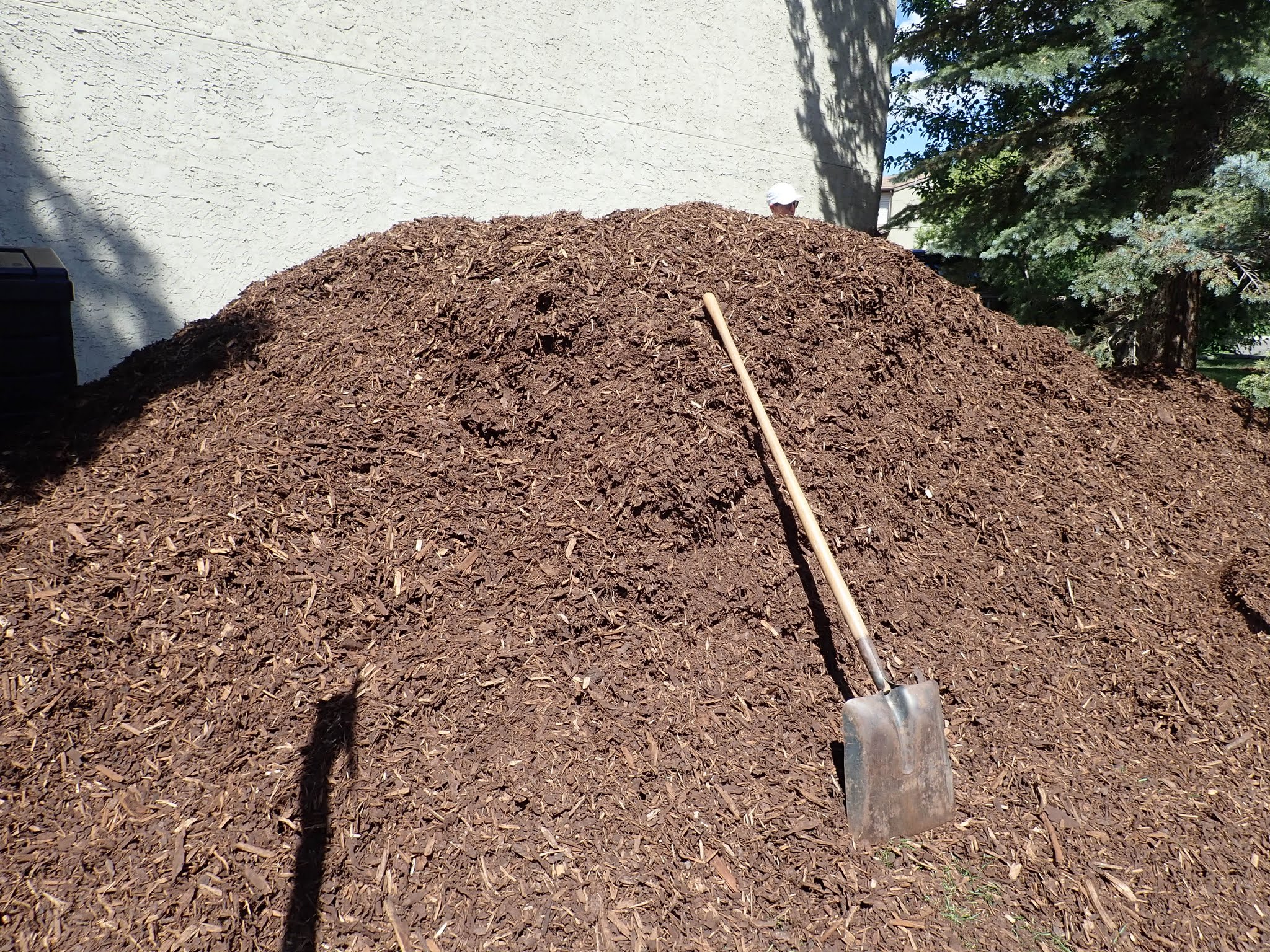
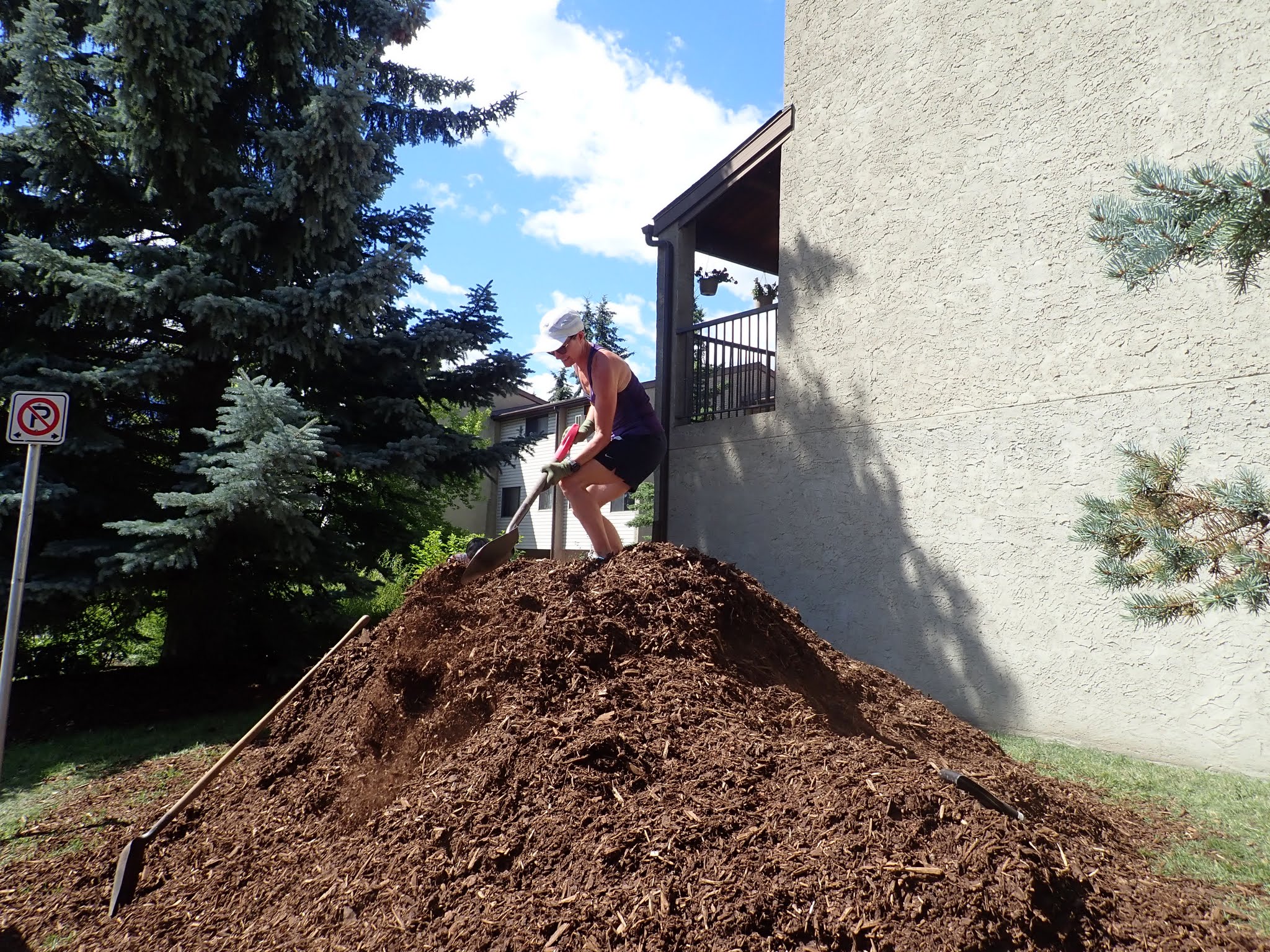
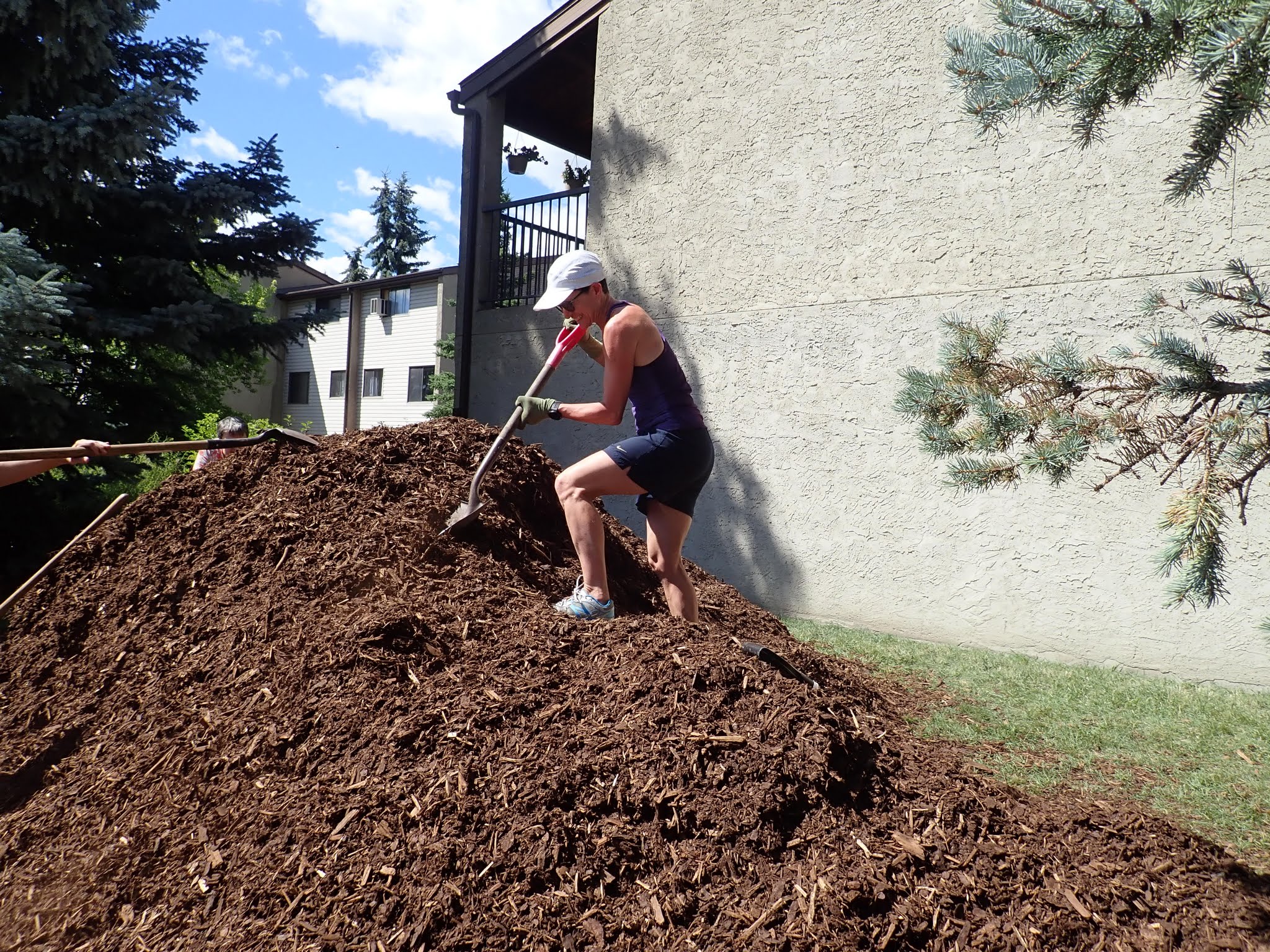
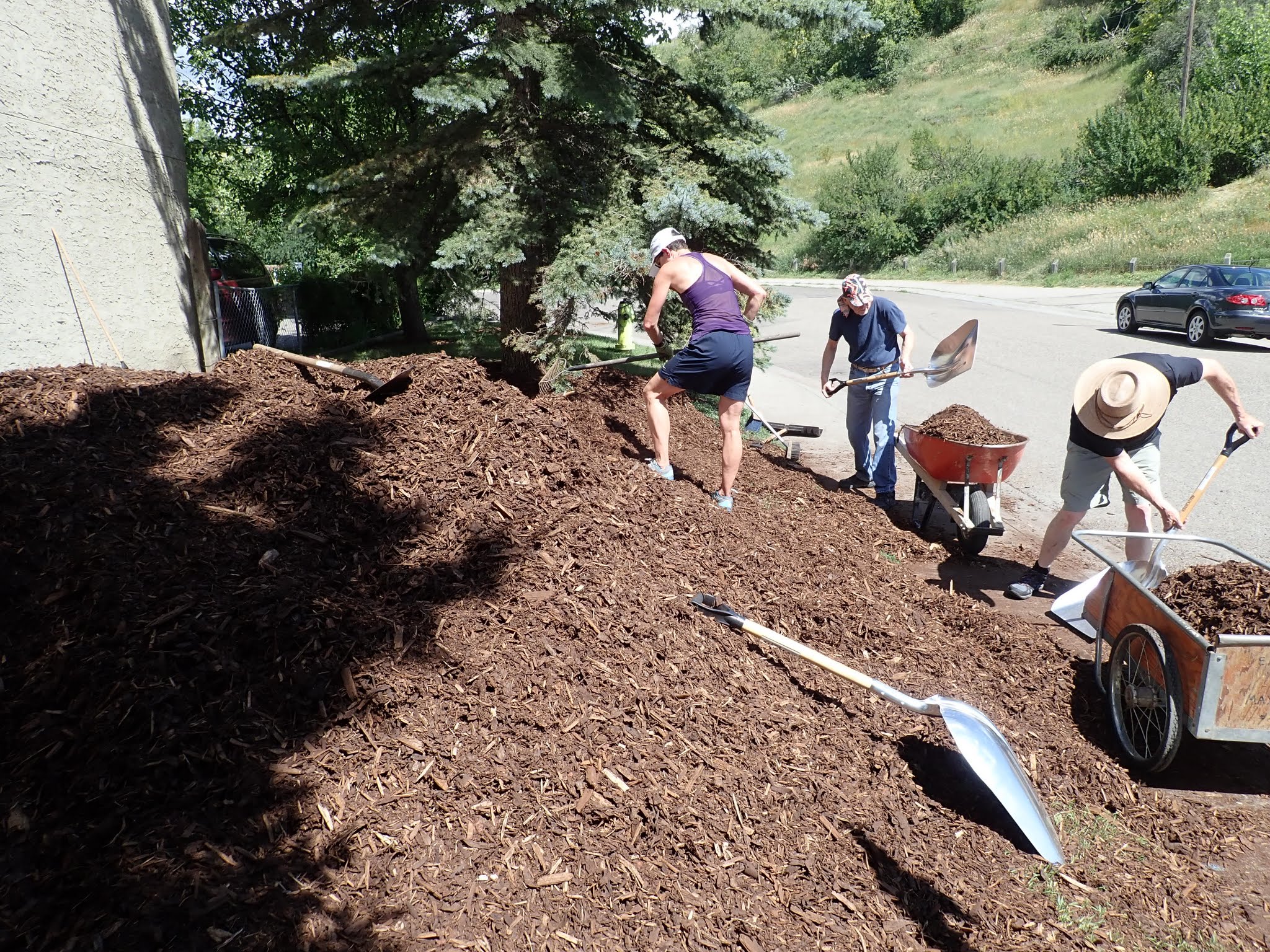


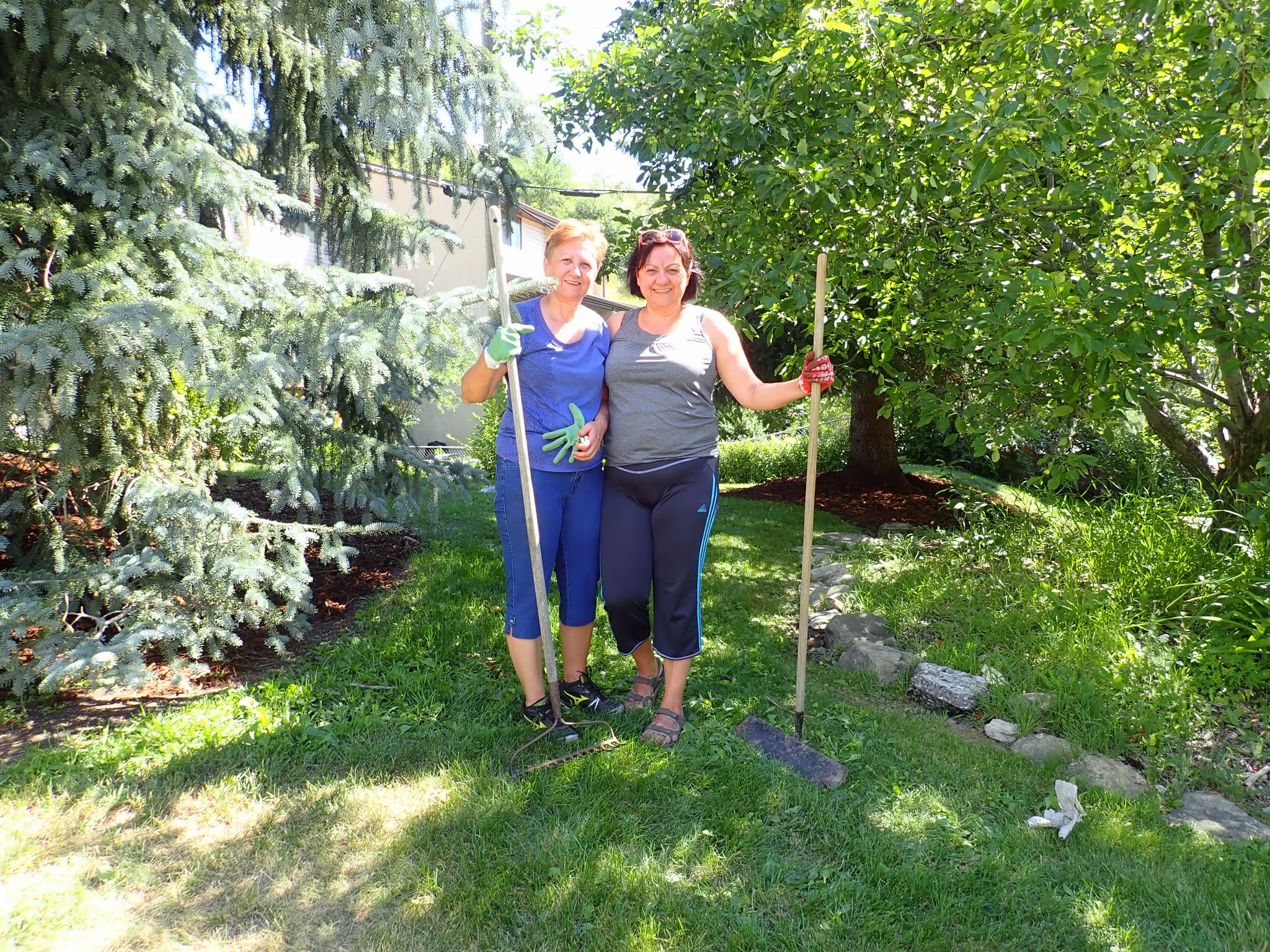
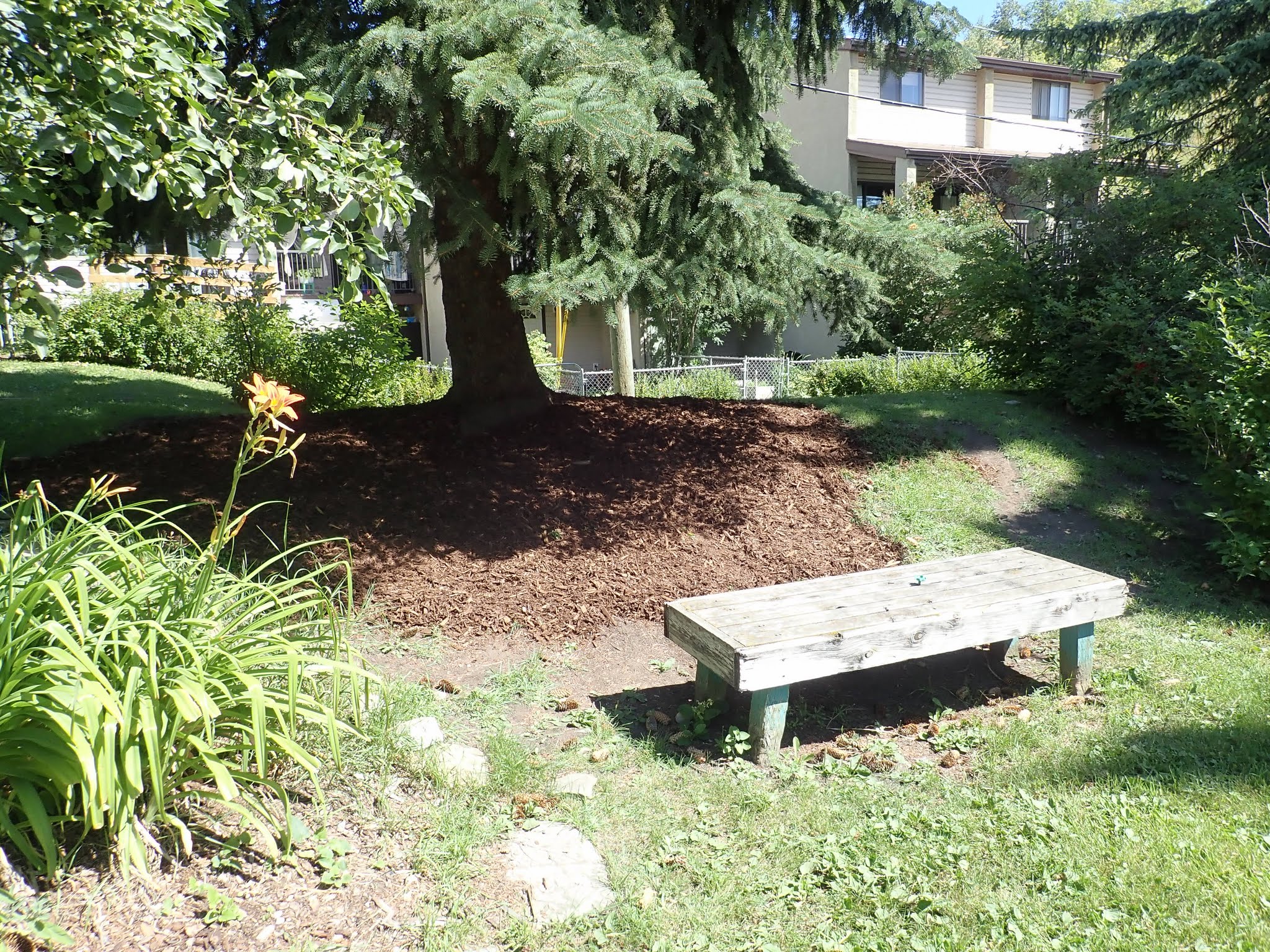

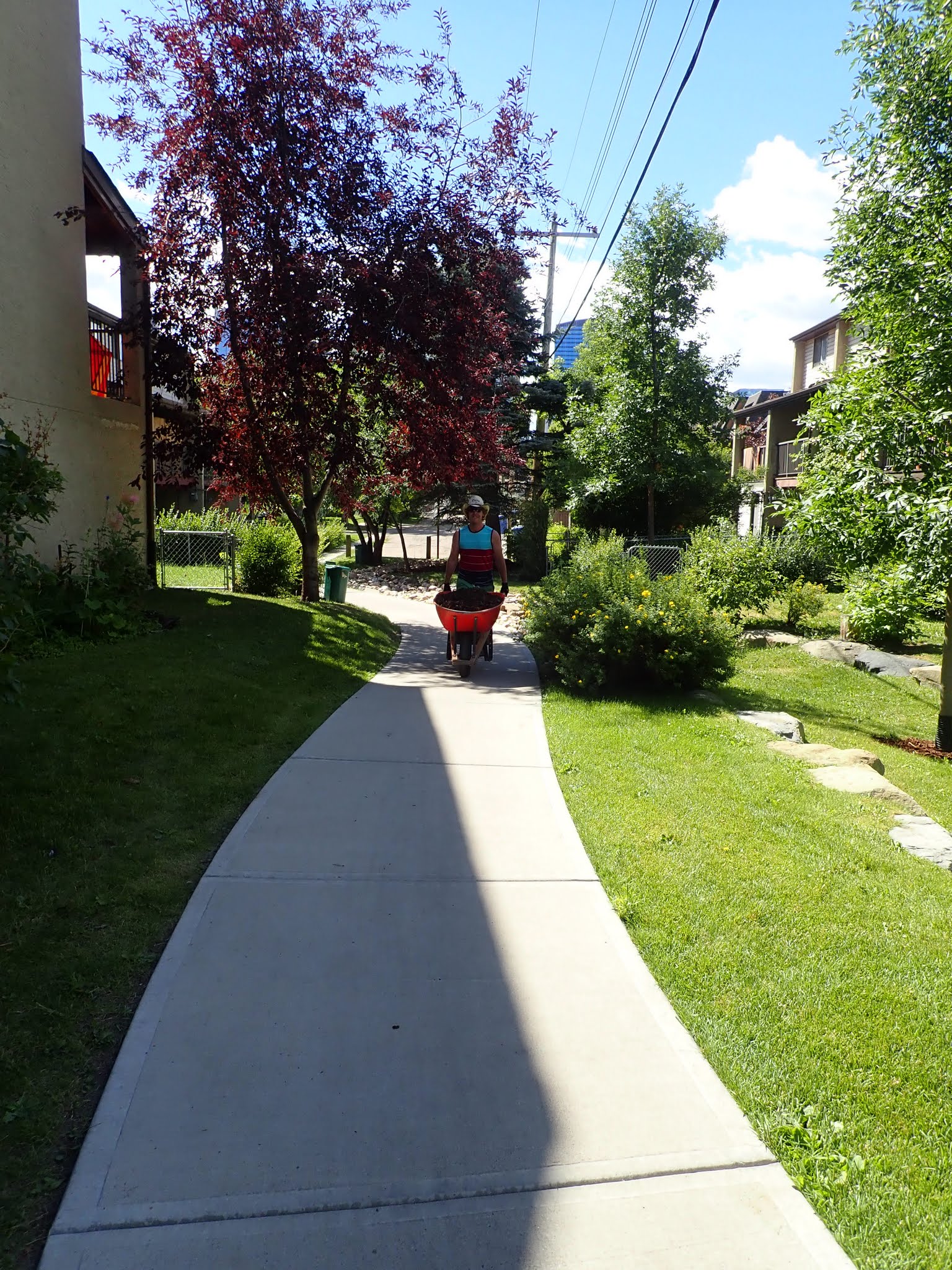
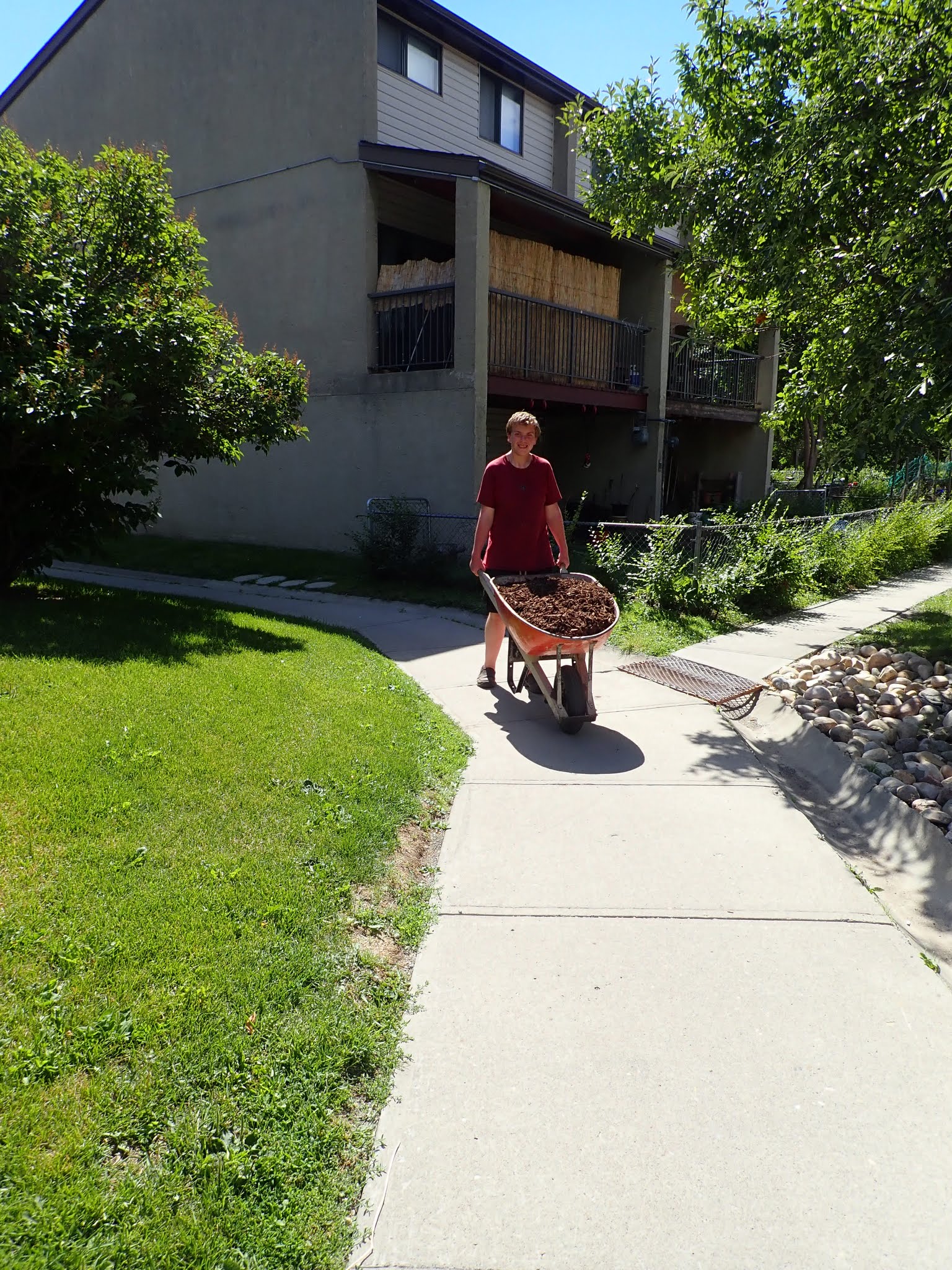

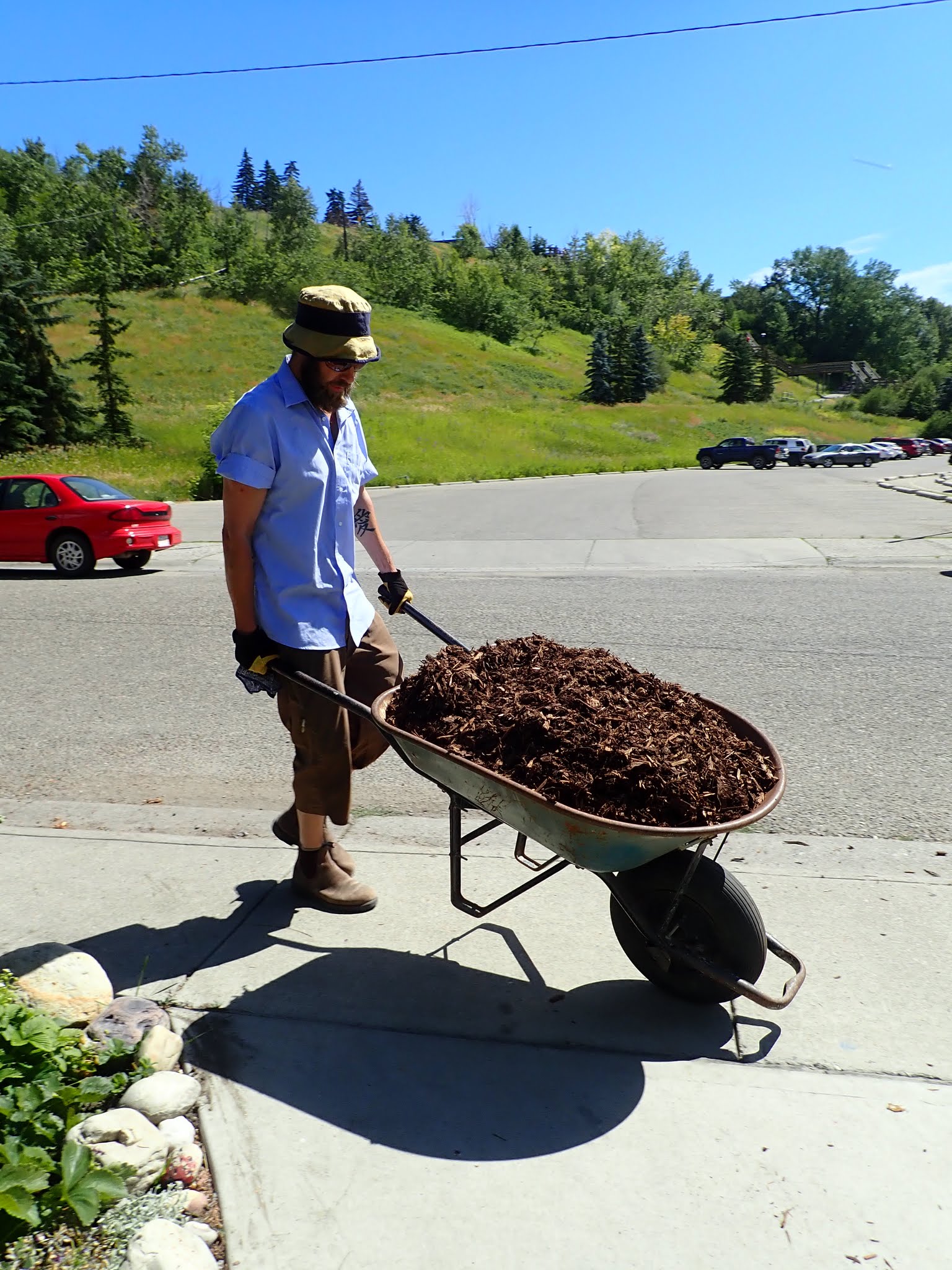
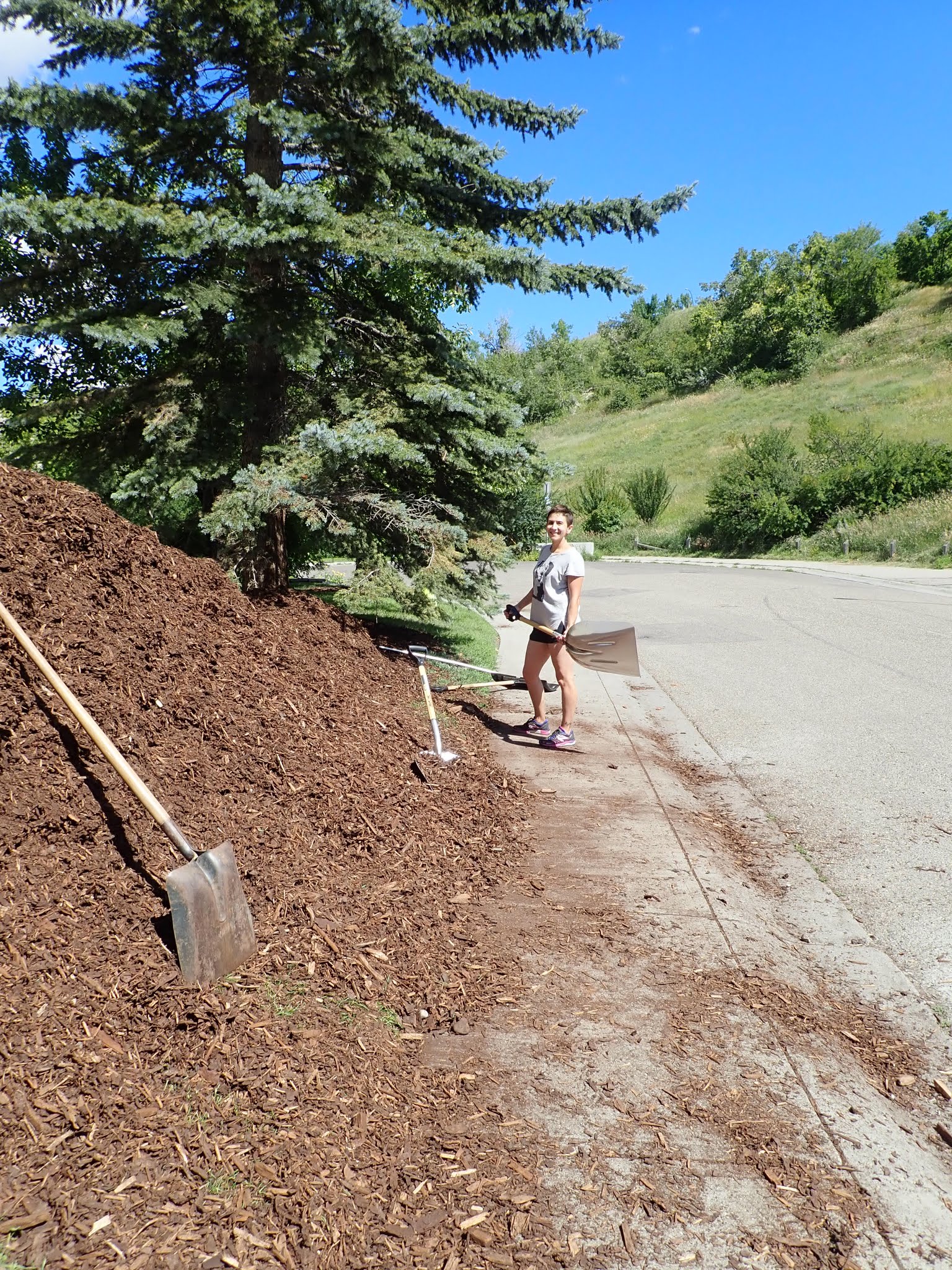
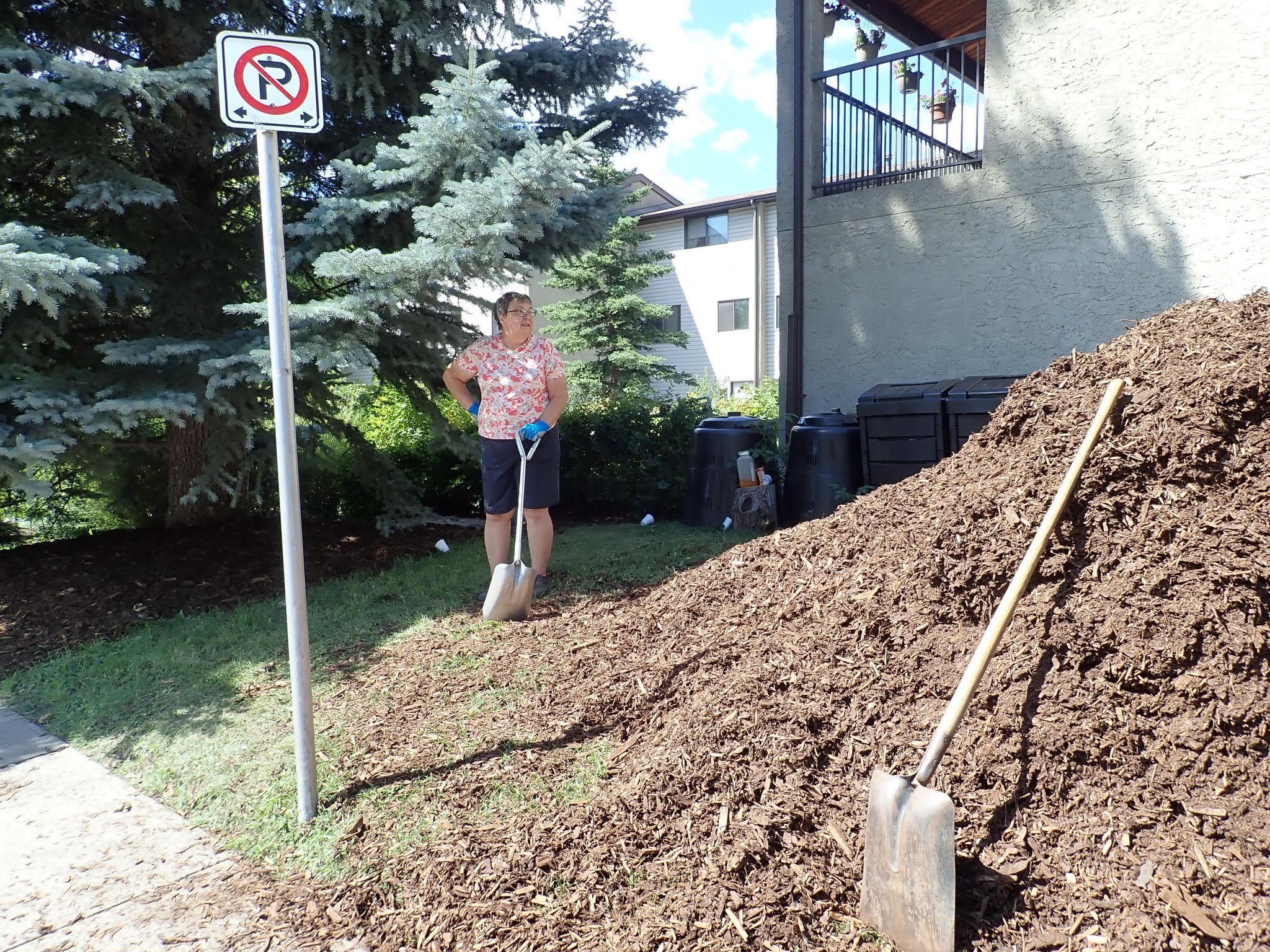
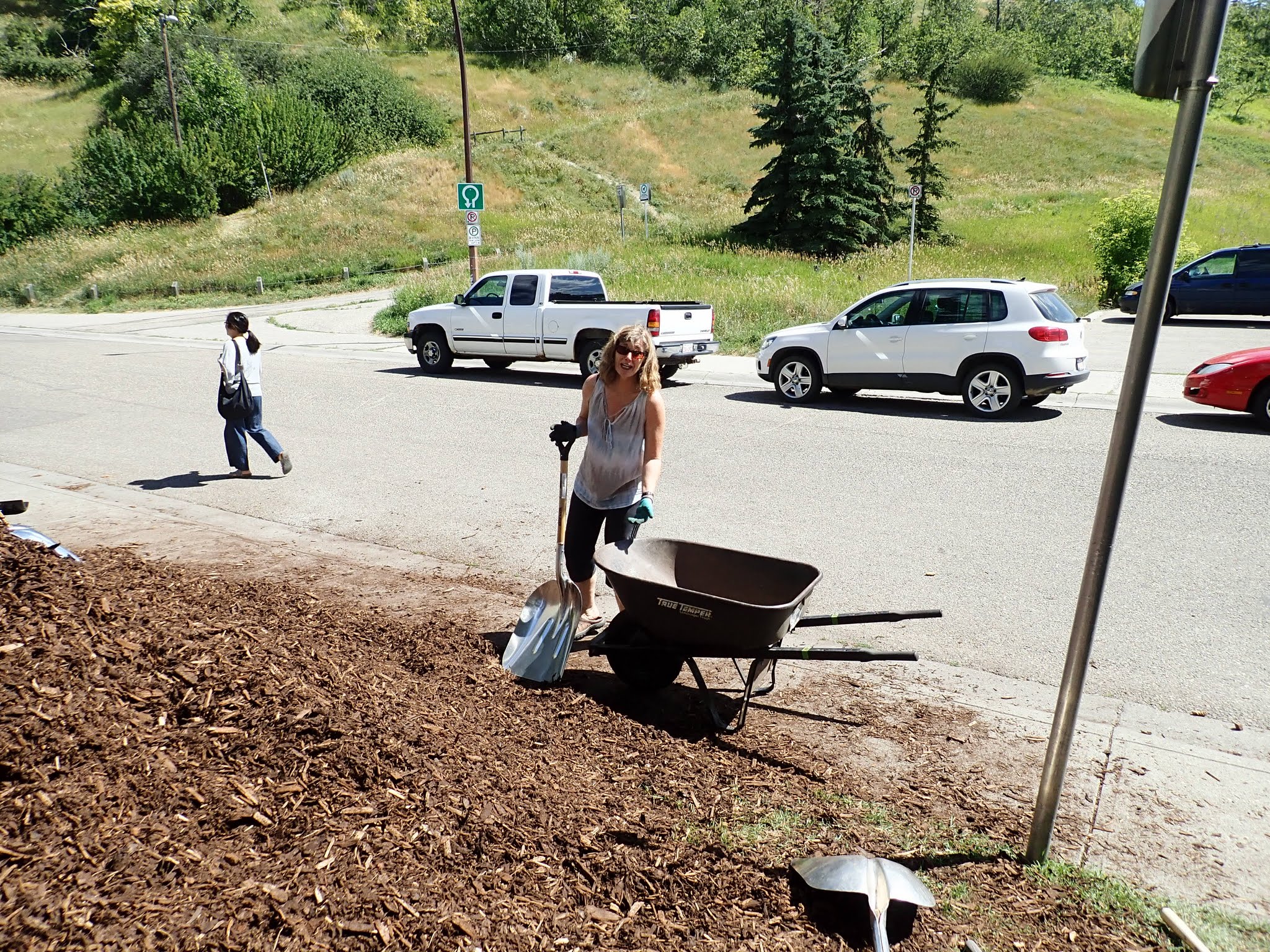
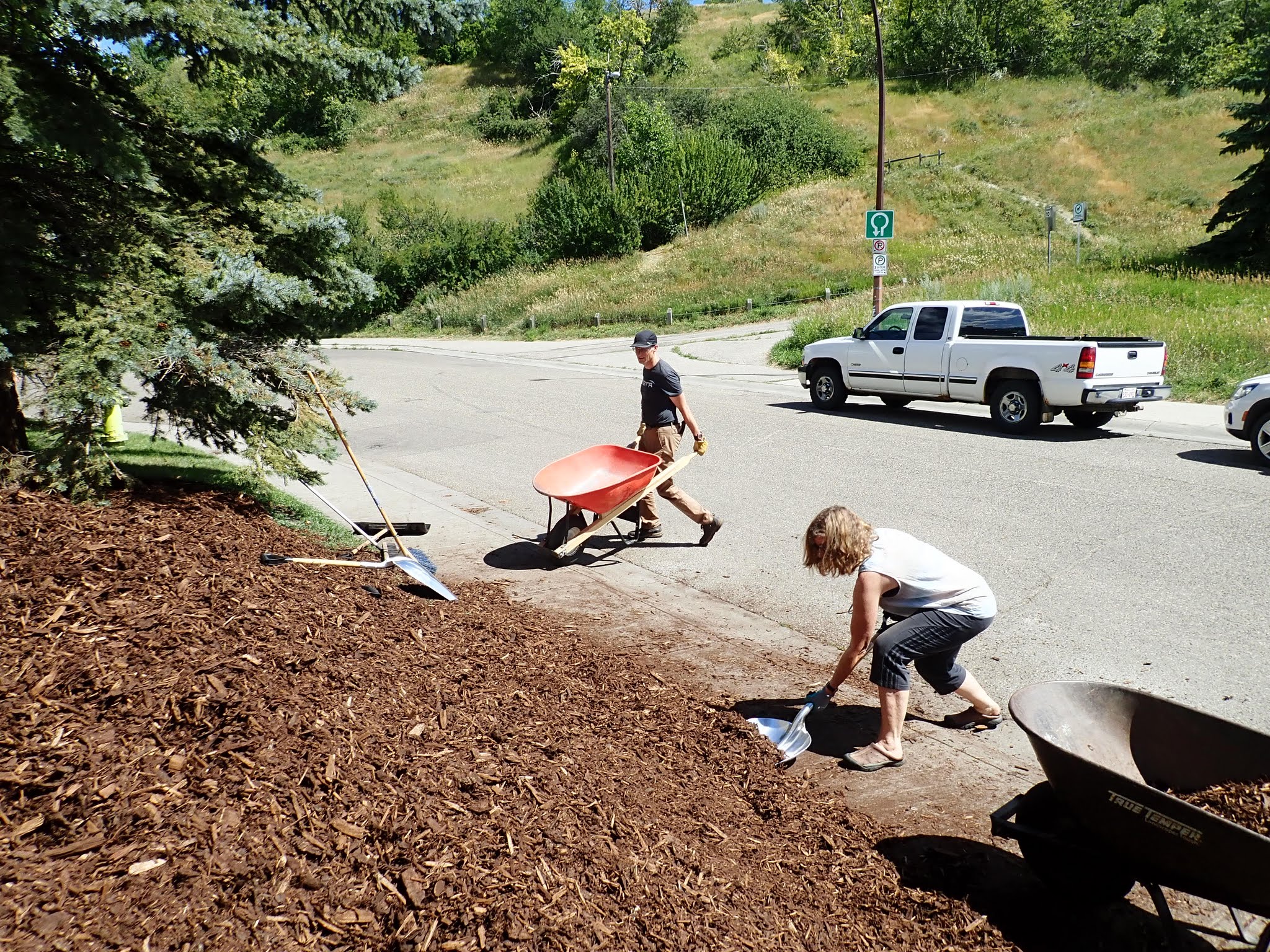
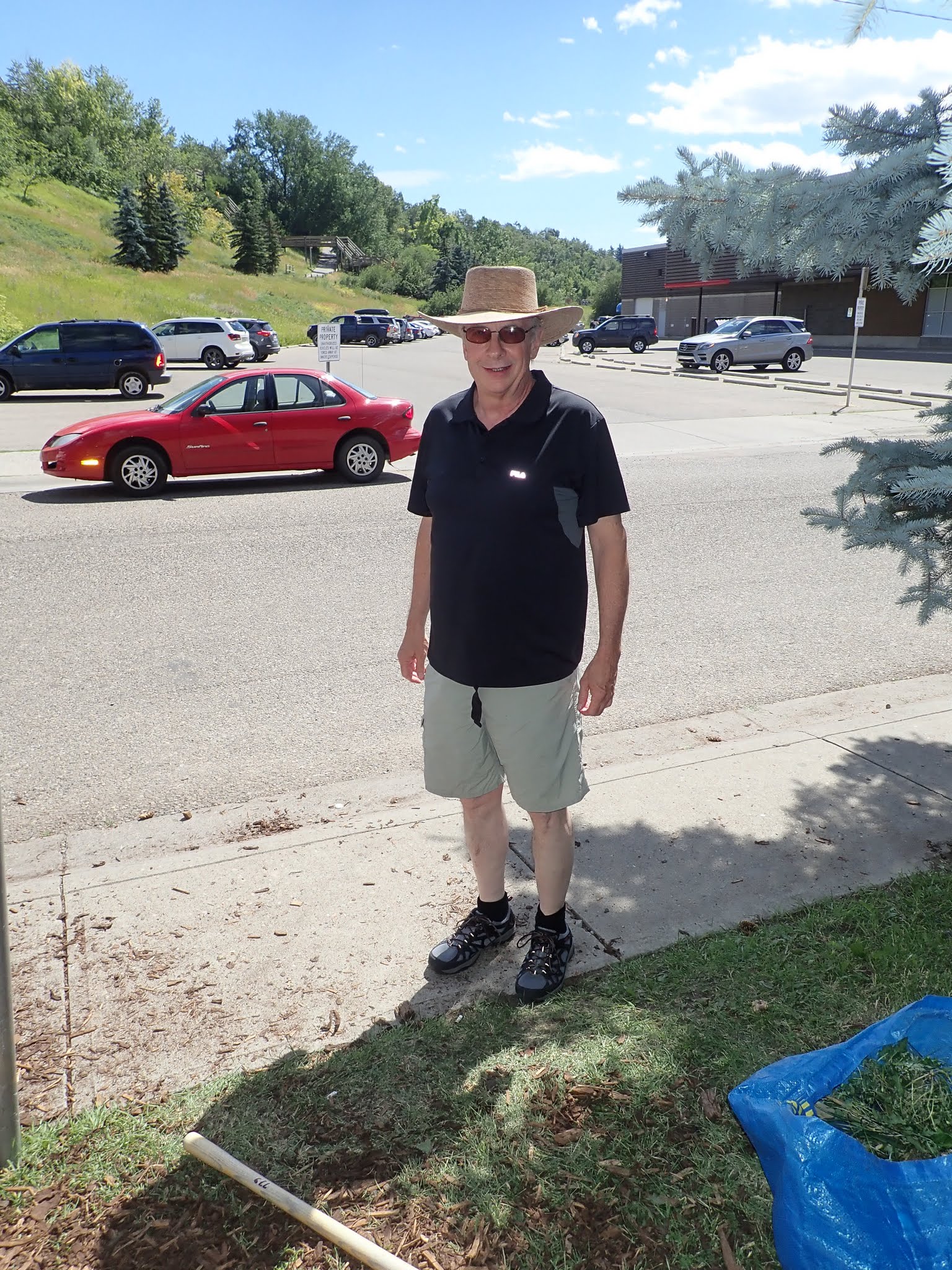
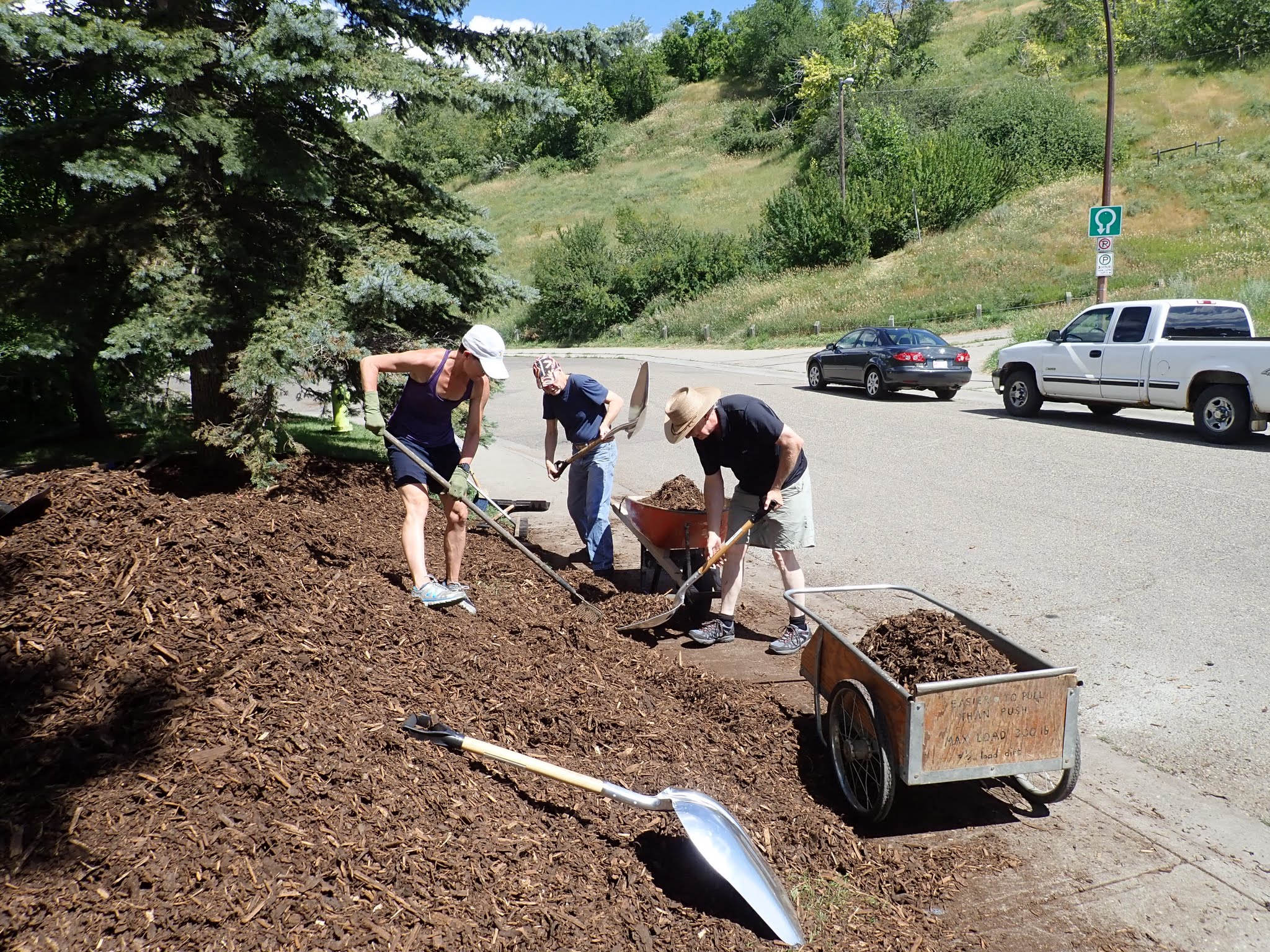
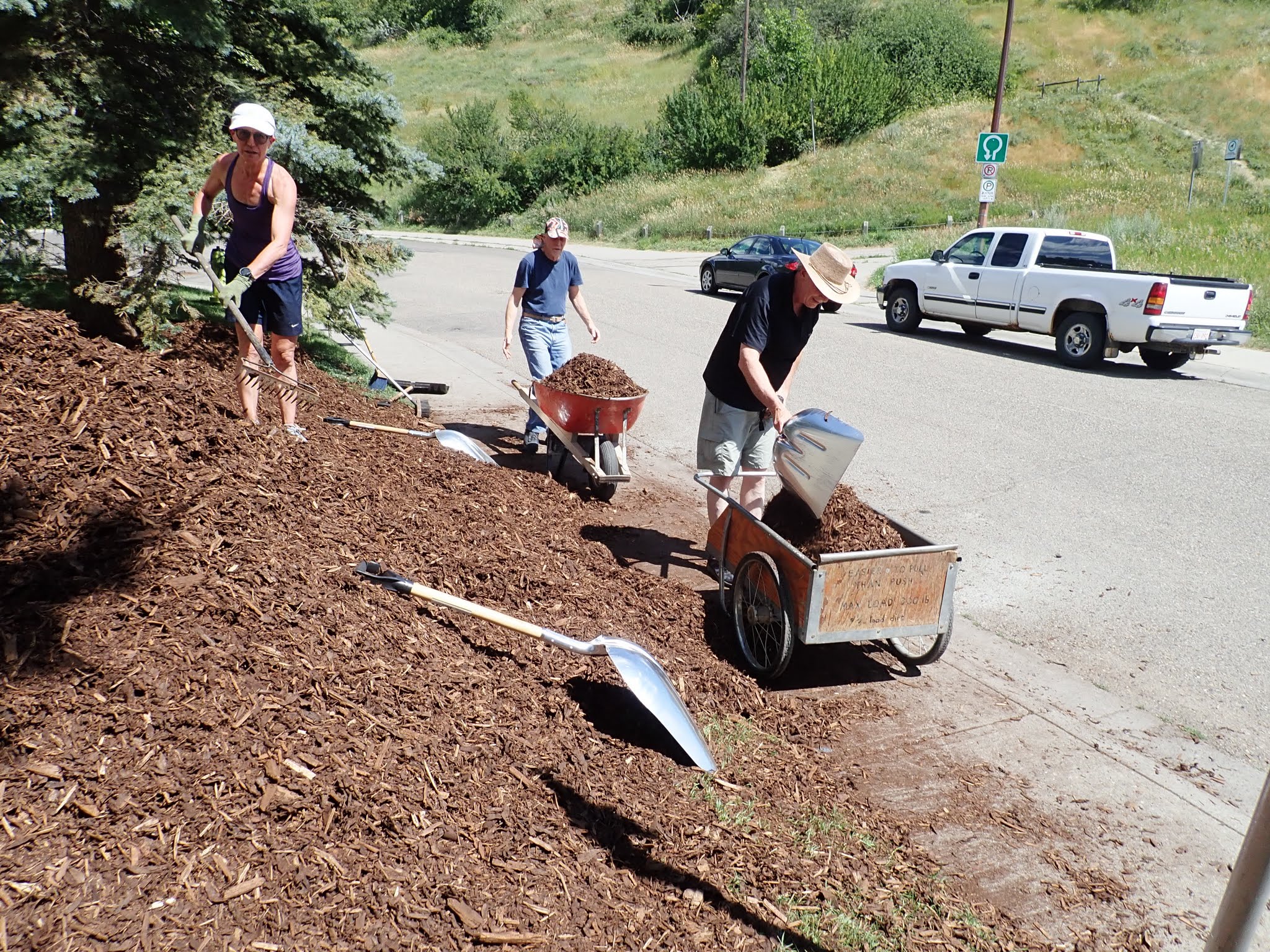
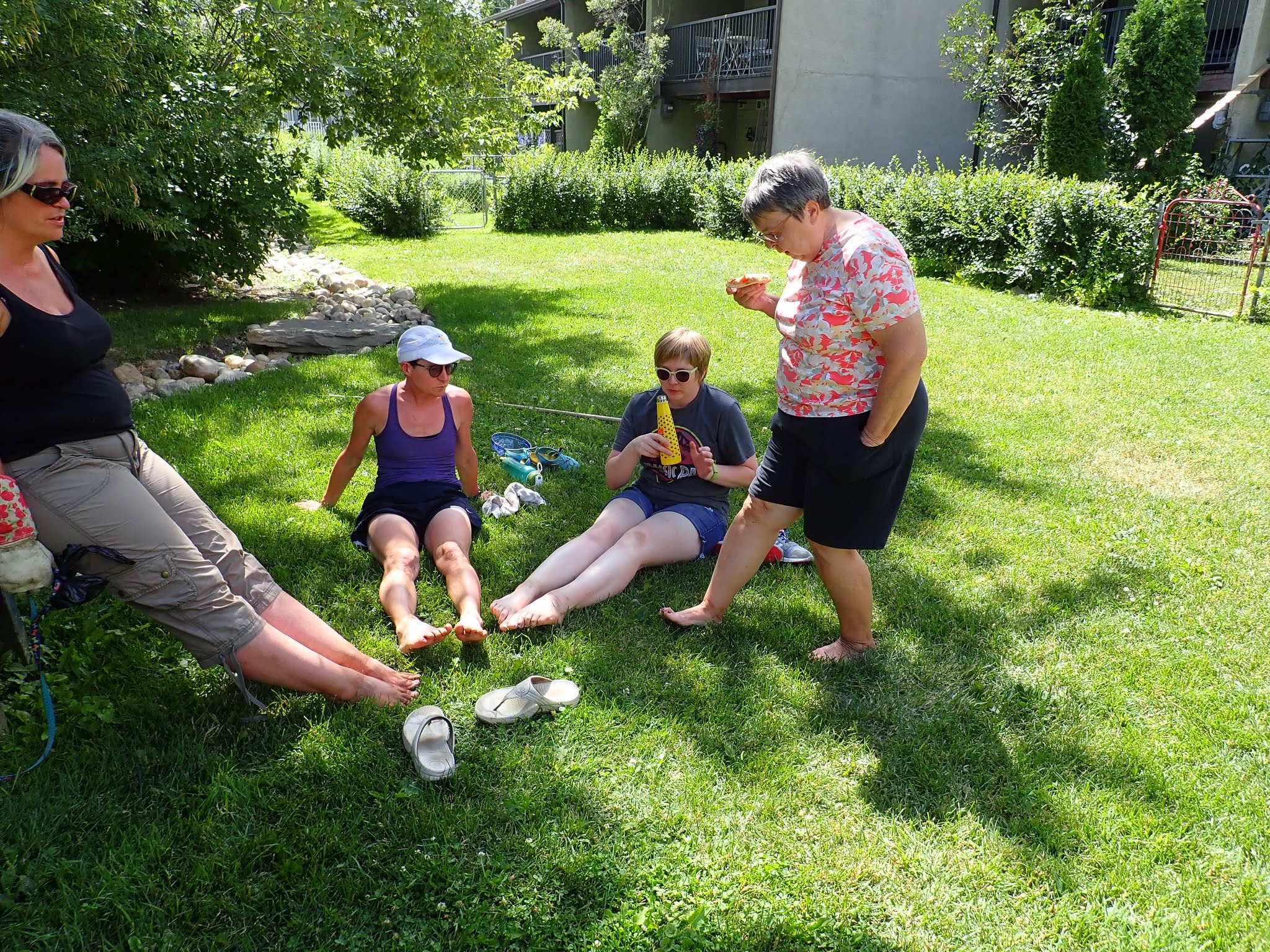
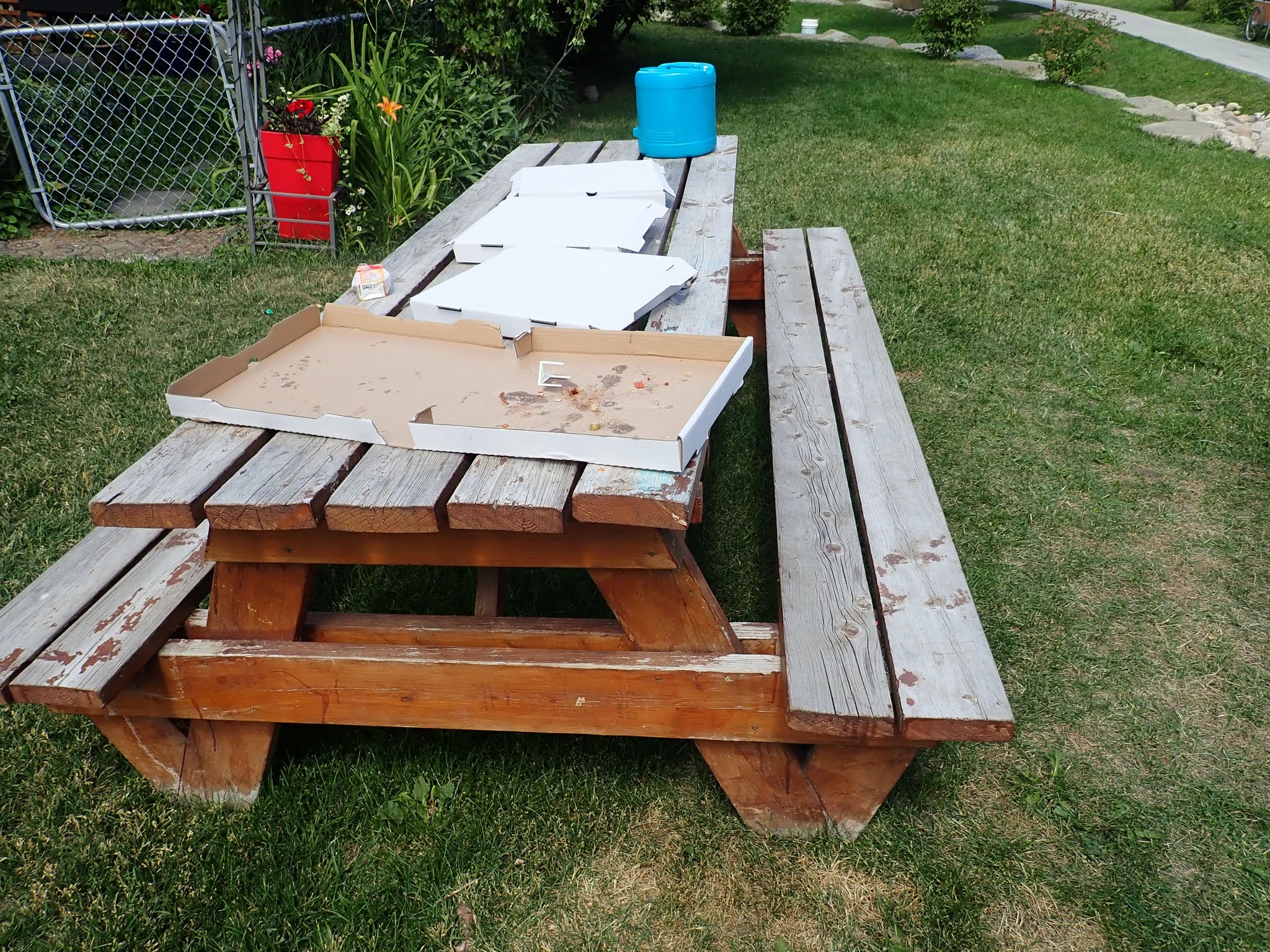
Submitted by Rachel Rose
Join in and celebrate the birthday of Sunnyhill Co-op! The social committee will be hosting a day of celebration on Saturday August 19th. Join us for food and conversation at 5:00pm in the commons. Hot dogs, birthday cake as well as beer and wine will be provided. Please bring a potluck item as well as your own plate and cutlery. Their will also be a bouncy castle from 1-8pm for the children.
We hope to see everyone!
Submitted by Pamela Boyd
Sunnyhill will begin compost pick-up at the beginning of September.
Blue Planet will be delivering green bins to sit alongside our blue recycling bins. Each Sunnyhill Unit will also be given a smaller household bin which you use at home and then empty into the green bins, which will be emptied weekly by Blue Planet.
What goes into the composting bins?
◦ Plate scrapings
◦ Eggshells and dairy products
◦ Meat, fish, shellfish and bones
◦ Jams, sauces, salad dressing and cooking oil
◦ Fruits and vegetables
◦ Pastries, cookies, cakes and muffins
◦ Bread, noodles, rice, beans and grains
◦ Nuts, seeds, chips, popcorn and candy
◦ Coffee filters and tea bags
◦ Leaves
◦ Branches and prunings
◦ Plants and weeds
◦ Grass clippings
◦ Cat litter!!!
…..way more than we can put into our own household composting bins.
But if you prefer to continue using your own that’s fine too.
Please get into the habit of composting, it helps to reduce our garbage and makes for a healthier planet all round.
TREE WATERING
In the hot sunny weather please could folks make a point of putting a sprinkler on near near trees and giving them a good watering. They can get very dried out at this time of year.
Submitted by Cindy Schnee
The Grounds committee does a walk around once a month to inspect common areas and members' yards. During the last one we found a lot of children's toys and clothing scattered throughout the playground/common area as well as a few dishes and other assorted items. This is just to let you know that if these things are still around during our next walk around (August 14 or thereabouts), we will collect them and put them in the dumpster.
It has come to our attention that children are playing in the caragana trees beside the picnic tables and as a result many branches are broken. On some branches the bark has been carved away. Please ask your children to not harm the trees.
During these hot days please water any trees in your yard as well as those close to you in the common area.
Thanks for your cooperation in keeping our co-op grounds in top form.
Grounds committee
Submitted by Cindy Schnee on behalf of the Grounds Committee
Submitted by Cindy Schnee and Eric Moschopedis
Neighbours Rue and Eno have been beating the heat by laying low and snoozing the days away. How about you?
Submitted by Cindy Schnee
You’re looking good! It took a second round of notices to some units, but we are delighted to report that as of June 18 all units have mowed grass and tidied their yards. Grounds members pulled a bunch of weeds from hedges on June 17. There are still some issues with dog feces, but we’ve made great progress. Yards in general look better than they have for many years.
We’ll be inspecting again around the 15th of each month to make sure yards are kept up to standards. Several co-op members found teenagers to do work they were not able to do themselves. Ask Andrea in the office if you are looking for help. Don’t forget the dumpster in the parking lot if you need to dispose of unwanted items.
We heard that some people had trouble identifying noxious weeds. Our biggest weed issue in the co-op is creeping bellflower. This perennial has low-growing clumped foliage in spring and grows to a 1-metre tall flowering spike in summer. The leaves are heart-shaped in early stage, later becoming lance-shaped, tooth-edged and coarse textured. Flowers are purple-blue 2-3 centimetres-long nodding bells; the blooms begin on the lower stem.
Once established, creeping bellflower is very difficult to remove as even the smallest tiny root fragments can grow entirely new plants. It also spreads very easily as each stem produces up to 15,000 seeds. The plant is resistant to some herbicides. Creeping bellflower is also known as garden bluebell, rover bellflower, purple bell, garden harebell, creeping campanula, and creeping bluebell.
We have asked our landscaping contractor, Curbside, to deal with weeds that we missed in the common area and by the hedges along the parking lot. Remember, some costs such as sod can be paid for with your unit fund. Also, parents and kids, please pick up your stuff in the common area.
Thanks again to everyone who rose to the challenge.
The Grounds Committee
Submitted by Richard Harrison
Sometimes during a discussion, it becomes pretty clear that no decision that everyone can live with is going to be made, even if it does get to a vote. There are several things that can be done at that point, and depending on how the meeting got there, the facilitator or a member from the floor can suggest which one to go with.
Remembering that a failed motion can only be revisited under special circumstances (see the section "The Passed is the Past ... Unless"), no one who makes a motion wants to see it defeated if it was presented without all the arguments in its favour made or the arguments against it answered. And no one wants to defeat a motion on incomplete evidence.
So if all a discussion about a motion needs is more time or information before the decision about it is fully informed, that motion can be either Tabled or Postponed at the will of the meeting. These two actions have the same result in the short-term: discussion about the motion stops. In the longer term, they are different.
Tabling a motion sends it off the agenda for an indefinite period of time -- maybe forever. But a tabled motion (Or, in Robert's actual words, "a motion laid on the table"), can be returned to discussion at any time in the meeting in which it was tabled -- again, at the will of the meeting. It's a kind of suspended animation with no fixed return-to-life hour within the meeting. However, the motion must be taken off the table in the next meeting, or it vanishes.
To table a motion, a motion to table needs to be made, seconded, and passed without debate with the simple majority of 50% plus one. There is one side-note here, and Robert’s Rules takes quite a bit of time with it: tabling is meant to help a group organize a discussion; it shouldn’t be used to cut off debate or consideration of a question. In such a case, the facilitator is tasked with calling the motion out of order.
Postponing a motion is putting it into suspended animation with a fixed time for its return. So a motion to postpone has to include a date or time for the discussion to resume -- even if that discussion is only to further postpone the motion to another time in the future. It requires a mover, seconder and, under normal conditions, after a debate on the merits of postponing, a simple majority vote. (In some cases, a motion needs postponing because it has become too large an issue to be discussed in the time allowed. In that case someone might move to postpone the motion and treat it at the next meeting as special motion – something to devote more than half the meeting to. And in that case, the vote required is 2/3.)
Sometimes it's clear that a motion doesn't have the support of the meeting or some argument against it is so persuasive that even the person who made it no longer believes it's right. I think it's possible to argue that that is discussion demonstrating its best properties. In such cases, out of respect for the meeting's time and thought, the maker of the motion might want to withdraw it from discussion. With the consent of the seconder of the motion, the motion is withdrawn, discussion on it ends, and the meeting can move on to other matters.
I've seen all three exit points for a discussion used in meetings, and each of them saves the meeting from discussions that are no longer grounded in the motion itself or could have led to those sorts of debates where everyone, even their winners, loses the goodwill of the meeting or the group.
I get asked a lot why I know these rules as well as I do -- or more importantly, why I like and believe in them. The historical answer is that they work to keep discussions on track and on time. They and their variations, adapted for the special needs of organizations such as Parliament, try to ensure that all people get a chance to speak; they work against the tendency of unregulated meetings to become places where the loudest voices carry the day. No set of Rules of Order will create decisions that everyone agrees with, but in my experience so far, Robert's Rules does go a long way to helping a group come to a decision that everyone can live with even if it’s one they didn't support.
These outcomes are the result of certain qualities in Robert's Rules that, once you get a feel for them, can make understanding them -- and predicting the decisions that they will guide you to -- easier. I'm not sure that I'm completely aware of what those qualities are, but after practicing Robert’s Rules for over thirty years, here's what I think they are.
One: Robert's Rules are rules in favour of the shyest person in the room. I don't know what kind of a person Major, later General Robert was, but he made it far in the US Army in the late 1800s – soon after the Civil War -- so I'd expect he was pretty clear, forthright, and demanding in his decision making. I expect he expected to be obeyed and for most of his active military life, he was.
It was his church group that gave him pause. Not being organized along military lines, their meetings frustrated him. I like that story, and I like imagining a group of men and women without rank stopping an army officer in his tracks. But I like to think, too, that Robert’s frustration points to something about the nature of his church community: everyone in it was equal before their God. So the question is, how should equals decide on a direction?
Robert was a student of the procedures used in Congress, and that provided him with the answer in a system of discussion that gives everyone their turn and no more than their turn. It appoints a temporary leader (we would say "facilitator", Robert's Rules now uses the word "chair") trusted by the group to make decisions according to the rules but whose power is also checked by the group as a whole (I'll talk about that in my section on "Loopholes and Challenges"), and right from the get-go, the first motion, a seconder is required; so anyone seeking to guide the direction of the group already has one person in it who’ll stand with them in that suggestion.
Two: Robert's Rules recognize that there are two kinds of votes. Again, I'll speak to this in detail later, but Robert realized that some decisions require more of what we would now call "buy-in" than others. In some cases, a simple majority (half those who vote plus one) is enough to assure the group that the decision in question is supported enough to warrant their support and not so impactful that it breaks the group up, or unreasonably binds the hands of those who follow. Things for us like whether we support the Rooftops initiative or what the Housing Charge will be are such decisions. Not that they're not important; clearly they are, and we desire more than just the half of the voters plus one that we need to support the motions that establish these actions, but such motions are limited in scope, and they need to be decided on in an ongoing way that can't be held up by objectors who lack the support of the majority.
But there are matters -- like bylaws and constitutions -- that do have effects on the way things are done that can outlast the participatory lives of the people who make decisions about them. For those decisions, Robert's Rules argues, a simple majority (who may be swayed by the conditions of the moment or opposed by a sizeable minority) aren't enough to cause such a change. For those changes, motions require a 2/3 majority vote, and that extra 1/6 portion of the group represents the best answer we have to the difference between the decisions we as a group have to make for ourselves alone and the ones we have to make for those who will come after us.
Three: Robert's Rules are only rules. They're not laws, and they don't try to be. Admittedly, any group has its moments where the will of the majority, either expressly by vote or by extension through people voted into positions of authority, is imposed on everyone. In democratic institutions, there are corrections in place for such moments, of course, and protections against abuse of power, but both of these systems can take time to work themselves out, and don't usually change the power structures themselves.
But Robert's Rules are constantly in front of us while we are in a meeting. In a sense, they are the procedures for free decision-making, which, to my mind, is decision-making that can explain itself. They do allow for variations on themselves with consent of the meeting -- things like allowing the maker of a motion to answer a question during the discussion, or the raising of "Points of Information" and "Points of Order" that both break the flow of a discussion when they are invoked and reconnect it when they're done.
And they allow us to tailor things to our own needs and best judgment. Even simple things like when we call the question, or move to adjourn, or suspend the rules a bit for an open discussion (one not guided by a motion), or vote by raising our hands. All these are variations on the Rules that the Rules allow to make things fit with the culture of the community that's using them to make decisions and deal with conversations that can be difficult to have. More and more I have become interested in working on a mutually agreeable and ongoing basis -- the way an ecosystem works – rather than in the top-down law-guided way that I see in a lot of institutions. To me, Robert’s Rules is the balance between what we have to do to make a decision and what we need to be free to do to make that decision truly ours.
Submitted by Bob Bott on behalf of the Grounds Committee
Hello from the Grounds Committee
This is especially for those of you who have not been looking after your yards. If you are physically unable to do so, let us know and we’ll see what we can to help.
Section 11-2 of the Sunnyhill Member Handbook sets out the Grounds Policy that all members are expected to follow regarding yards and entrances. Now that warmer weather is here, it might be a good idea to review this, especially these provisions:
Storage: Acceptable items for outside storage are lawn furniture, flowerpots, barbeques, and in-use motor vehicles and bicycles. The Grounds Committee must approve any permanent outdoor structure or modification such as sheds, dog houses, sand boxes or decks or the storage of boats, trailers or derelict motor vehicles.
Unit Property Standards:
· Grass should be neatly trimmed and bald spots reseeded
· Property should be clear of noxious and unsightly weeds
· Hedges should be trimmed and free of weeds
· Hedges should not overgrow walkways
· Pet feces should be removed promptly
· Spills of oil or similar contaminants should be cleaned from parking pads
· Front and rear areas should be clear of junk and garbage
Enforcement: Friendly persuasion will be the main method of enforcing the above standards. If problems persist, however, the Member will be advised in writing and given a reasonable amount of time to address the issues. As a last resort, a contractor will be hired to do the remediation and the cost will be billed to the Member.
We plan to again bring a dumpster on site this summer so members can dispose of unwanted items, especially those that are not in compliance with the policy. Please help us tidy up the co-op without having to resort to enforcement actions.



